Radio designers of cellular/4G, microwave radio, test equipment, and military subsystem applications rely on high quality local oscillator (LO) to achieve system level targets of low BER (bit error rate), low spurious output, and low phase noise. All RF and microwave communication and sensor systems, whether based on analog or digital modulation, require a clean LO signal source; the higher the radio capacity, the higher the LO signal requirements. There are many different architectures available, but one of the most common methods of generating a stable LO source is to combine a low phase noise voltage controlled oscillator (VCO) with a stable reference voltage and a phase locked loop (PLL) to form a frequency synthesizer. However, designers looking for the best LO performance are bound to face many of the challenges associated with the interaction between PLL/frequency synthesizers, VCOs, charge pumps and loop filters, not to mention the board layout and poor power supply noise. The problem. ADI's core expertise is in frequency generation components such as MMIC VCO, phase-locked oscillator (PLO), low noise prescaler, phased phase detector (PFD) and a range of dual modes with RF input frequencies up to 13.6 GHz. (decimal/integer) PLL/frequency synthesizer IC. The industry-leading ADI integrated VCO PLL products are listed in Tables 1 and 2. These integrated VCO PLL products cover RF and microwave frequencies from 25 MHz to 13.6 GHz.
Table 1. Summary of PLL Performance for ADI's Integrated VCO
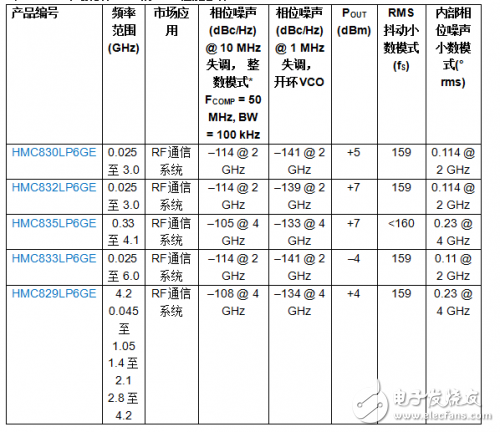
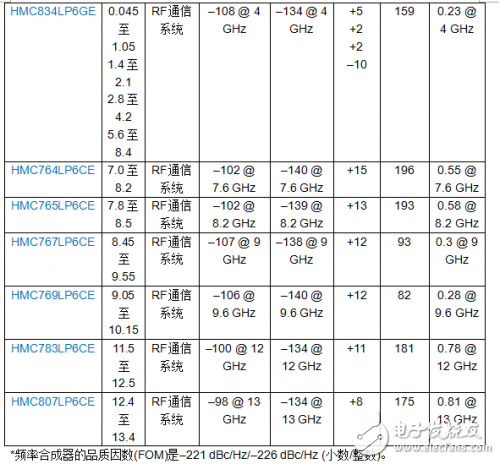
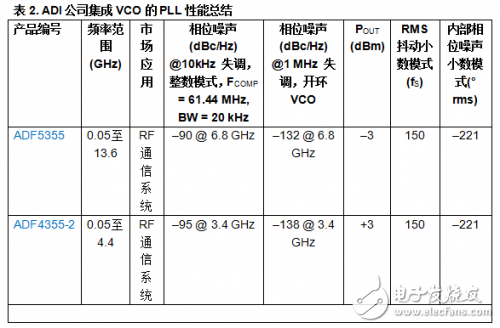
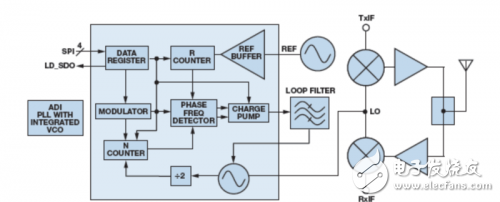
Figure 1. Functional block diagram and typical application circuit for a PLL product from the ADI Integrated VCO.
As shown in the functional block diagram of Figure 1, these products implement advanced fractional-N frequency synthesizers and ultra-low noise VCOs in standard 5 mm & TImes; 5 mm and 6 mm &TImes; 6 mm QFN plastic packages; this high level of integration Minimize the number of external components. Designed for ultra-low phase noise commercial and military applications, including a very low noise phase frequency detector (PFD), a precision controlled charge pump and an advanced modulator design that provides ultra-fine frequency stepping. The architecture features ultra-low near-carrier phase noise and low spurs for wide loop bandwidth and faster frequency hopping and low humming; spurious output is low enough to eliminate the need for expensive direct digital in many applications Frequency synthesis (DDS) reference. PLL for Integrated VCO for RF Market Applications Each product in the family combines a high performance fractional-N PLL/frequency synthesizer with a fully integrated low noise VCO. The PLL architecture of the integrated VCO for RF applications enables high performance VCOs to achieve voltage tuning below five volts (see Figure 2). Op amps are no longer needed in loop filters, saving cost and board space while improving performance. The PLL with integrated VCO can be locked at an extreme temperature and can then operate over the entire temperature range without relocking or recalibration; this feature is required for high reliability applications, but not in some competitive solutions. Provide this feature.
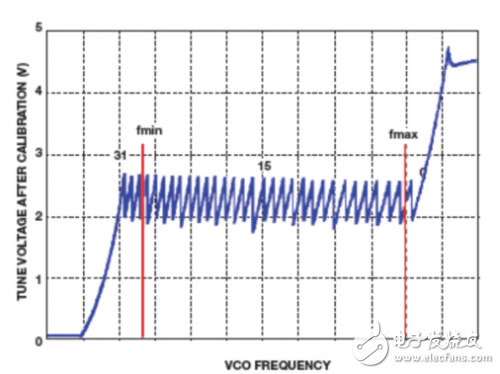
Figure 2. Tuning voltage vs. frequency for the PLL HMC830LP6GE with integrated VCO.

Figure 3. The SSB phase noise of the PLL HMC830LP6GE with integrated VCO versus offset frequency.
As shown in Figure 3, these devices have excellent phase noise performance, typically 10 dB better than competing devices in-band or away from the bottom, and all do not require a choice between low spurious or low noise modes. The integrated noise in the 100 Hz to 1 MHz range is typically –55 ​​dBc, equivalent to 0.1° rms jitter, or 278 fs rms at FOUT = 1 GHz.
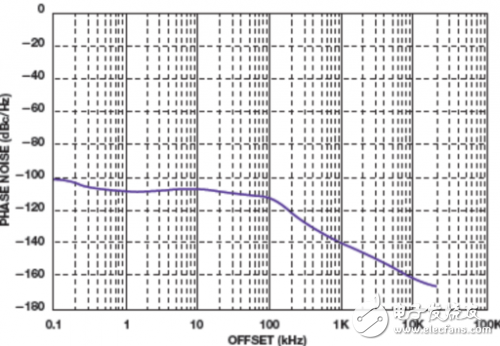
Figure 4. Worst spurs, fixed 50 Mhz reference, output frequency = 2 GHz.
As shown in Figure 4, the HMC830LP6GE has a significant improvement over alternative integrated solutions.
The temperature range at the edge of the HMC830LP6GE band is stable, ensuring that there is no “pressure differentialâ€.
For example, the HMC830LP6GE produces approximately 5 dB near-carrier phase noise and 7 dB phase bottom at an offset frequency greater than 20 MHz, both of which are lower compared to the TI LMX2581. In addition, the HMC830LP6GE also provides superior spurious performance, with low fractional spurs throughout the band and a cleaner overall spectrum output.
The ADF5355 integrated VCO's PLL covers the widest spectrum of the spectrum from 55 MHz to 13.6 GHz, while the ADF4355-2 has a frequency range of 55 MHz to 4.4 GHz.
The ADF5355 and ADF4355-2 feature a new VCO topology and architecture, and are developed with ADI's newly patented advanced SiGe-BiCMOS process for excellent VCO phase noise performance.
Both devices integrate an ultra-low phase noise VCO that produces –138 dBc/Hz (1 MHz offset) phase noise at 3.4 GHz for the ADF4344-2, while the ADF5355 produces –132 dBc/Hz at 6.8 GHz (1 MHz offset) phase noise. In ultra-wideband RF and microwave communication applications, this ultra-low phase noise has the advantage of improving overall system error rate and increasing data throughput rates, providing better noise immunity and a wider dynamic range. ADI's latest cost-effective, ultra-wideband PLL synthesizer ICs feature up to 125 MHz phase comparator frequency and 38-bit resolution to reduce jitter and allow for extremely fine step sizes compared to discrete GaAs deployments. Integrated PLLs and VCOs in an advanced BiCMOS process dramatically reduce package size and power consumption. In addition, because the operating frequency of a single PLL frequency synthesizer can be configured from 55 MHz to 13.6 GHz, designers can reconfigure their system designs more quickly and reduce device inventory while still supporting multiple bands.
PLL for integrated VCO for microwave market applicationsThe integrated VCO PLL HMC764LP6CE has been optimized for narrowband, high performance microwave communication applications. Analog Devices is the industry's first to introduce integrated PLLs and VCOs with frequencies above 6 GHz. In addition to providing ADI's superior microwave VCO performance, these products add the functionality of an integrated advanced fractional frequency synthesizer. Typical applications include microwave and millimeter-wave radios, industrial/medical test equipment, military communications, electronic warfare (EW), and electronic countermeasures (ECM) subsystems.
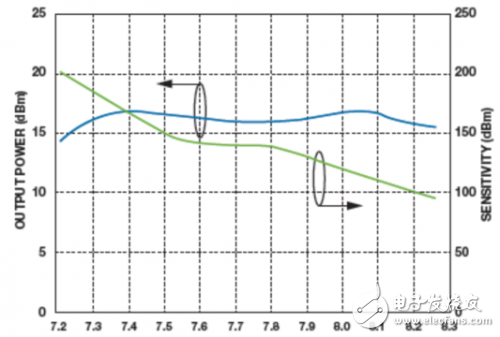
Figure 5. Tuning sensitivity and RF output power of the PLL HMC764LP6CE with integrated VCO versus output frequency.
As shown in Figure 5, the HMC764LP6CE has stable tuning sensitivity and output power of up to 16 dBm in its bandwidth, making it ideal for direct drive of many ADI high linearity, double balanced and I/Q mixers as well as upconverting and down. The LO part of the inverter product.
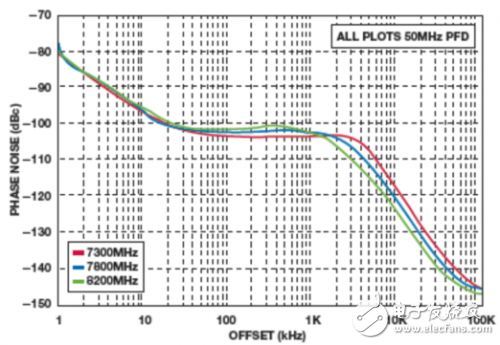
Figure 6. SSB phase noise of the PLL HMC764LP6CE with integrated VCO versus offset frequency.
Figure 6 shows the superior single sideband (SSB) phase noise performance of the HMC764LP6CE versus offset frequency for the low, medium, and high frequency ranges. The data is measured with a reference frequency of 50 MHz, a loop bandwidth of 100 kHz, and a PFD comparison frequency of 50 MHz. Due to the single-chip structure, the phase noise performance is stable under temperature and mechanical shock conditions. In addition, the built-in FSK mode allows the device to be used as a simple, low-cost direct FM source.
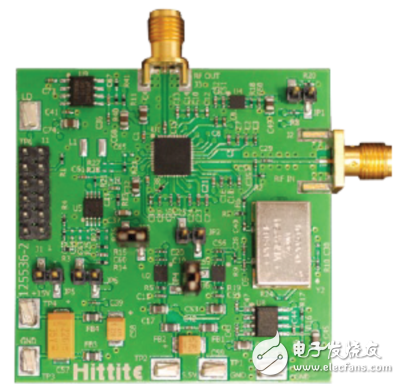
Figure 7. PLL evaluation PCB with integrated VCO, included in each designer's kit
Even with such advanced features and high integration, developing high-performance programmable local oscillators requires a lot of design time. As a result, ADI has developed a PLL reference designer suite with an integrated VCO that allows for immediate measurement of the design at hand.
The typical evaluation PCB shown in Figure 7 is part of an easy-to-use, universal evaluation kit that minimizes design time and facilitates rapid prototyping. The reference designer kit includes an onboard reference oscillator and several regulators and supports a common loop filter configuration. With the included software, users can program PLLs and access their advanced features. The full operating guide provides step-by-step instructions for quick power-up and initialization of the evaluation board. This guide provides a comprehensive discussion of the components used in the evaluation board, covering the reconfiguration of the evaluation board for external reference voltages, and the implementation of on-board selectable sequential passive or active loop filters.
Each reference designer's kit includes ADI's proprietary ADIsimPLL design tool, which allows users to evaluate PCB loop filters based on their specific application-specific criteria. Provides comprehensive PC-based PLL control software to program the PLL with a PC-compatible register file via the USB interface. The user can evaluate the fully locked local oscillator in a very short time with only one PC, one signal analyzer and several DC power supplies. ADI's team of skilled application engineers can also help customers quickly become familiar with this unique product.
ADI's integrated VCO PLL combines low phase noise, advanced features and ultra-small size, making it ideal for many small form factor applications such as microwave/millimeter wave radios, test equipment, microwave sensors, fiber optic communications, and military communications and sensors. .
Hybrid frequency synthesizers typically use a fiberglass substrate material with a discrete VCO, a large resonator, and a metal stamped cover. This assembly technique can cause problems related to RF grounding in the user system and can also create annoying electrical and howling coupling effects. Compared to discrete hybrid frequency synthesizer/VCO configurations, ADI's integrated frequency generation solution helps designers achieve stability, reliability and small size targets. Compared to large hybrid designs, ADI's integrated VCO PLLs have a much smaller resonator and therefore excellent squeak performance. These integrated VCO PLL products are available in a RoHS-compliant, QFN leadless package, making them ideal for high-speed, high-volume SMT assembly lines.
Common Mode Choke (line Filter)
Common mode choke coils are used to suppress common mode noise. This type of coil is produced by winding the signal or supply wires one ferrite core. Since magnetic flux flows inside the ferrite core, common mode choke coils work as an inductor against common mode current. Accordingly, using a common mode choke coil provides larger impedance against common mode current and is more effective for common mode noise suppression than using several normal inductors.
Customized High Current 1mh Choke Coil Toroidal Inductor Common Mode Inductor
Common mode Inductor, also known as common mode choke, is commonly used in computer switching power supplies to filter common mode electromagnetic interference signals. In the board design, the common mode inductor also acts as an EMI filter to suppress the electromagnetic radiation generated by the high-speed signal line from radiating outward.
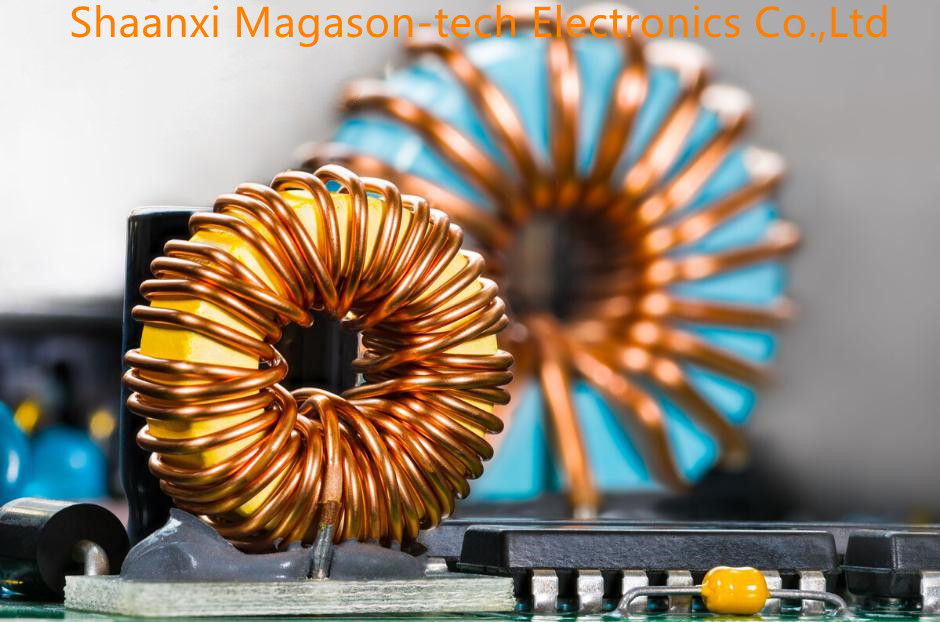
Toroidal Inductors are used for applications that include current sense transformers, common mode inductors, switching regulator inductors, input filter inductors, and more. These inductors provide excellent value - they are generally smaller in size and cost less than other inductors.
Toroidal Inductors provide a number of advantages over other inductor varieties, which include:
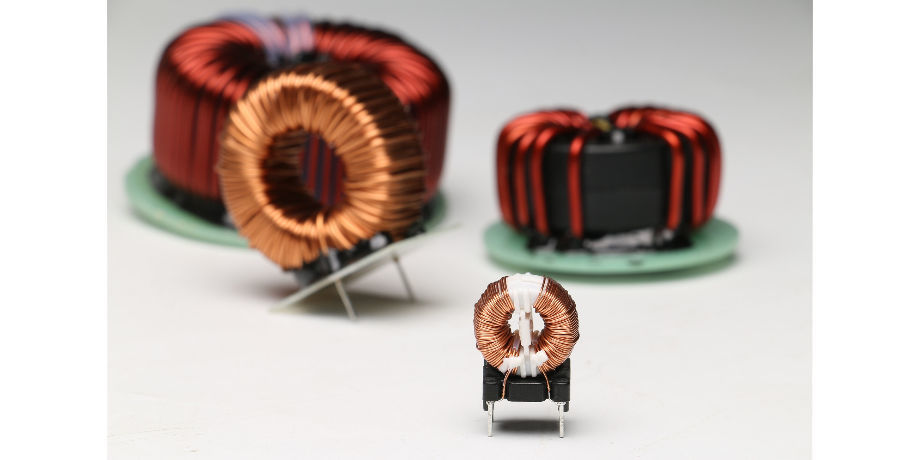
|
T38×19×13 |
||
|
Dimention(mm) |
Pin Quantity(pcs) |
Pin Array(mm) |
| 50*35*53 | 6 | 18/25 |
| Resistance(MAX) | Inductance | Test Condition |
| L1-2=L4-3=L5-620mΩ | L1-2=L4-3=L5-6=1.0mH MIN 100K,1V | 100KHZ/1V |
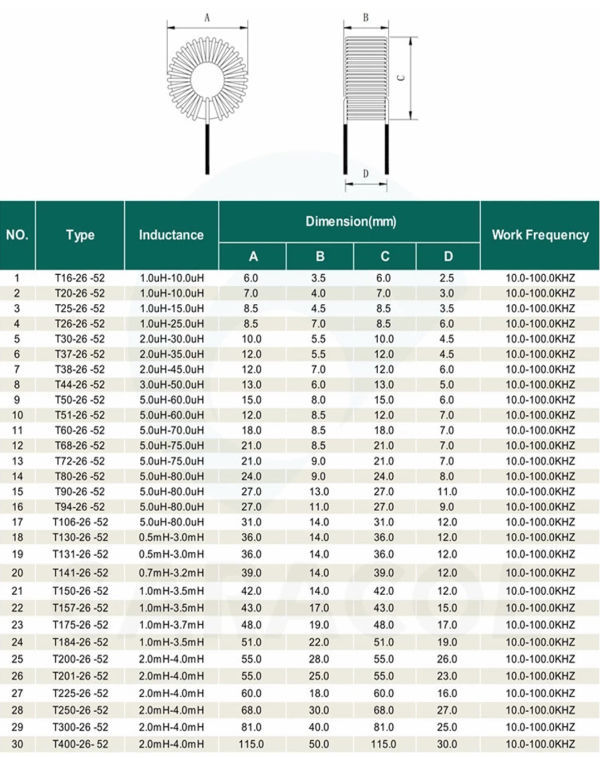
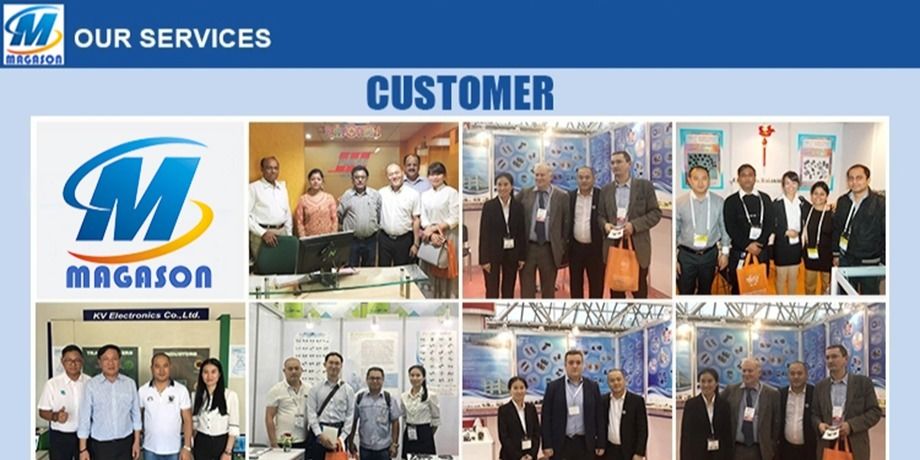
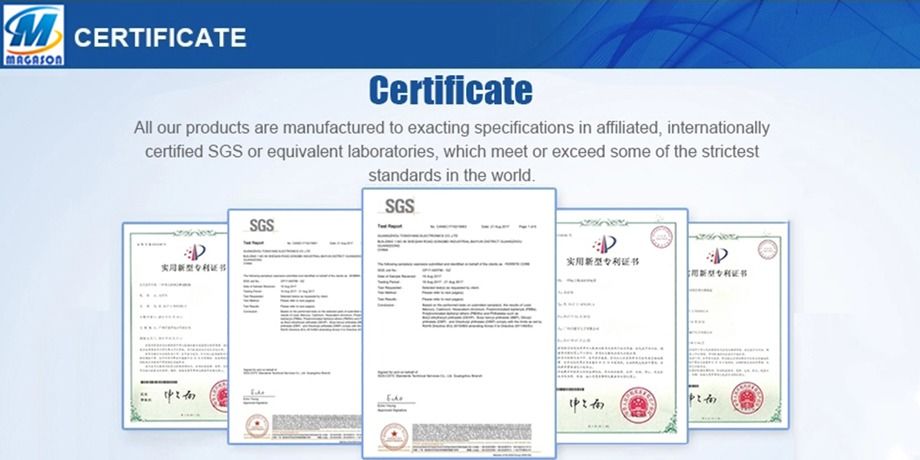
FAQ
1-MOQ?
We will work hard to fit your MOQ .Small purchase quantity is ok.
2-Payment term?
T/T, Western Union, Paypal, Credit Card
3-Delivery port?
Shenzhen, Guangzhou, Zhongshan, Hongkong.
4-Shipping date?
About 7 days when we check the payment.
5-Do you produce the core and bobbin by yourself .
Yes.we have 2 head company,1 subsidiary company.one is bobbin factory,one is core factory,last one is transformer factory.
6-Where is your factory?
In ShaanxI
Common Mode Choke,Toroidal Inductor Choke,Common Mode Choke Coils,High Power Toroidal Inductor
Shaanxi Magason-tech Electronics Co.,Ltd , https://www.magason-tech.com